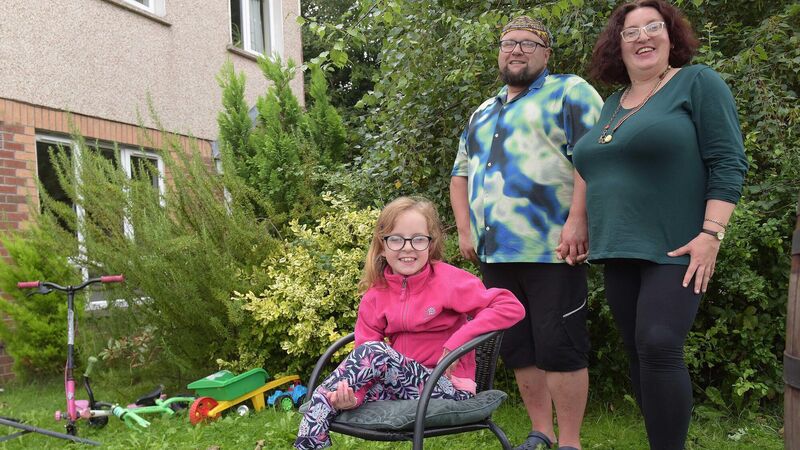Sepsis: 'The doctor said Barbara was the sickest child he had ever seen'

Agnieszka and Piotr Data with their eight and a half year old daughter Barbara who as a result of developing sepsis had her legs amputated below the knees, and has very recently come home from hospital. Photograph: Moya Nolan
There have been many petrifying moments for Agnieszka and Piotr Data since their eight-year-old daughter got sepsis four months ago.
There was the moment early on when a doctor said Barbara was the sickest child he had ever seen.
“This doctor wasn’t young. I began to feel scared,” recalls Drogheda-based Agnieszka, a mum-of-four.
There was the never-to-be-forgotten terror of their child suffering cardiac arrest as she arrived by ambulance at Temple Street Hospital.
Yet, it all started innocuously enough, a sore throat on a Thursday in mid-May. By Friday, Barbara had a chesty cough.
The GP thought it was a viral infection and that it would pass. But then came fever and sleepiness.
“I gave her Nurofen at night. She was doing better. On Saturday morning she wasn’t bad,” says Agnieszka.
But, within hours, Barbara’s condition worsened. “She was gasping for air, her lips were blue. I took her to the hospital — at reception, they wrote ‘Covid?’.”
Agnieszka pleaded for her daughter to be seen ahead of other patients. By now, sepsis was on her mind — while pregnant with her youngest, she had watched a sepsis awareness video in a hospital waiting room.
“So I knew the symptoms. Barbara had no rash so I wasn’t suspecting sepsis. But I knew not to be afraid to ask ‘could this be sepsis?’”
One doctor said ”don’t exaggerate”, another took her question seriously. An x-ray showed pneumonia badly affecting Barbara’s lungs.
“She hadn’t passed urine since that morning. Her heart rate was very high, and her oxygen levels and blood pressure were very low, so they started giving her oxygen and medication. It didn’t work.”
On advice from Temple Street, Barbara was intubated; she was to transfer to the Dublin hospital. By now she had been diagnosed with septic shock.
Nuala Clarke, sepsis nurse lead for Children’s Health Ireland (CHI), says this is the most severe form of sepsis.
Sepsis itself is a life-threatening condition triggered by an infection — in Barbara’s case, Strep A — that affects the organs and kills one in five who develop it.
“Sepsis can be triggered by different kinds of germs ... most often when bacteria get into the blood, lungs, kidneys, or abdomen. It can be difficult to recognise — symptoms often mimic that of other, less serious illnesses so it’s important to know the signs,” says Clarke.
- Very fast breathing
- Fits/convulsions
- Skin looks mottled (patchy, irregular colour), bluish or pale
- Rash that does not fade when you press it
- Unusually sleepy and difficult to wake
- Feels unusually cold when you touch them
- No pee for more than 12 hours
For under-fives, watch the following in particular:
- Vomiting repeatedly.
- Dry when you change them; no wet nappy for the previous 12 hours.
- According to the 2021 National Sepsis report, 2,607 children had a diagnosis of sepsis and 112 died from it.
Agnieszka recalls her panic during the wait for the ambulance: “Doctors said if it didn’t come quickly, Barbara mightn’t survive.”
Agnieszka stayed home to mind her other children, aged 13, 10 and three, while Piotr went to Temple Street.
“When he arrived, he was told Barbara was under CPR — she’d had a cardiac arrest and they were trying to bring her back to life.”
Time passed. Piotr learned Barbara’s heart was working — but she had organ failure: her lungs and kidneys were not working.
“She was critically unstable. They couldn’t make her stable though they worked very hard all night,” says Agnieszka, who will never forget Piotr’s phone call the next morning: “They wanted us both by her bedside because she might not survive.”
Agnieszka travelled to Temple Street and in ICU was “terribly shocked” to see how Barbara was: “By then she had the rash. She was greenish, blueish, her feet and legs were turning blue—blue like frostbite. She was lying on the bed, not moving, tubes all around her. She had collapsed lungs, she wasn’t peeing — she was on dialysis. They said her chances were very slim.”
After 36 hours’ dedicated care by Temple Street staff, Barbara’s parents were told everything had been done that could be done. She now needed to go to Sweden for ECMO (extracorporeal membrane oxygenation) which uses a man-made heart and lung to support the body when a person’s own heart and/or lungs are too sick to do it.
Ireland does not have a respiratory ECLS (extracorporeal life support) service but there is a long-standing arrangement with the Karolinska Institute, which provides a Europe-wide retrieval ECMO service.
“[They] are one of the most experienced high-volume ECMO centres in Europe,” says a CHI spokesperson.
But ECMO is high-risk. And Barbara’s parents needed to decide fast if they wanted to proceed: “They said she could die while being transported. She could have a brain haemorrhage or stroke. She she could die at any stage of the treatment. Or it mightn’t work or, even if it did, she might be severely disabled. They told us there was no other chance for her. For us, even if it was the lowest percentage chance, we were going for this.”
Barbara spent 14 days on life support in Sweden: “It was scary, but they were very confident. It made us calm. We trusted them completely. We were beside Barbara’s bed all the time, helping to wash her, talking to her.”
Just days after arriving, there were precious hopeful signs: “There was [some] improvement — her lungs were breathing on their own a few times an hour — the first sign of hope. Each day she was getting better. After a week, they planned to disconnect her from ECMO but she’d still need a ventilator. They started waking her up. She was conscious, looking at us, still very weak. She couldn’t move or talk.”
Barbara returned to Temple Street ICU in late May, still on dialysis and a ventilator. In mid-June, she transferred out of ICU to a ward, where she stayed for two months. Still undergoing numerous wound debridement procedures, these showed significant damage to deep tissue in Barbara’s legs and hands.
“We knew from the beginning, amputation could be an outcome of septic shock,” says Agnieszka.
Barbara had a double below-knee amputation in July and also lost some fingers.
Telling their daughter — “very active, loves gymnastics, cycling, running” — about the amputation was understandably tough: “The day after [the procedure] she asked about her legs. Before [amputation] her legs had felt very heavy and cold — there was no circulation. [Now] she said ‘I feel them very light and not so cold, are they good now?’ That was when we told her they couldn’t be saved.
“She was very, very sad. The second day after the operation was the worst. She was in pain, crying, but once the pain was managed, she slowly started to accept it. Piotr and I tried to find on social media people without legs, to show her she isn’t the only one.”
Two weeks ago, Barbara attended the National Rehabilitation Hospital, where she will get prosthetic legs and learn to walk again. “When a bed becomes free, maybe in October, she’ll go,” says Agnieszka.
Her daughter is now “medically totally healthy” — she returned to school last Thursday: “She has always been a positive girl, a great sense of humour, very talkative, she has lots of friends.”
Tomorrow is World Sepsis Day and Agnieszka wants everybody to know the symptoms of sepsis: “Sepsis can be very quick. It can happen to anyone. And time is very important.”
Clarke echoes this: “Sepsis-management in children needs prompt recognition. If suspected, antibiotics are required as soon as possible to treat the infection. Early and appropriate antibiotic therapy [is] associated with reduced mortality.”
“If your child seems sicker than normal to you,” says Clarke, “or is being treated for infection that’s not getting better, trust your instincts and get urgent medical help. Don’t be afraid to ask: ‘Could this be sepsis?’”
In Drogheda, Agnieszka says the family couldn’t be happier: “It’ll be a challenging new life for her, but we’ve got our Barbara back and that’s the most wonderful thing.”







